





BIRDING MILESTONES

Birding Milestones
(updated September 9, 2008)
- 1731
-
Mark Catesby visits America 1712-1726 and later writes Natural History of Carolina, Florida and the Bahama Islands, which includes the first color depictions of North American birds and other animals. Also numerous plants in background, an approach later adapted by Audubon. He is also an early proponent of bird migration as an explanation for comings and goings of species. His pictures are published in 1731 and until 1743.
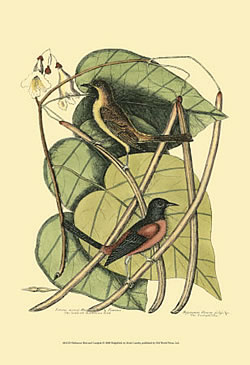
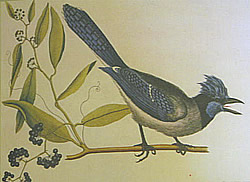
- 1735
- Carl Linnaeus (Carl Linné, Latinized as Carolus Linnaeus, also known after his ennoblement as Carl von Linné, 1707 –1778) was a Swedish botanist, physician and zoologist who laid the foundations for the modern scheme of Binomial nomenclature. He is known as the father of modern taxonomy, and is also considered one of the fathers of modern ecology. The first edition of Systema Naturae is printed in the Netherlands in 1735. It is an eleven page work. By the time it reaches its 10th edition (1758), it classifies 4,400 species of animals and 7,700 species of plants.
- 1741
- Georg Steller (1709-1746). On Vitus Bering's second Kamchatka Expedition, Steller goes ashore on Kayak Island for a few hours in 1741, then later gets ashore for two days on Nagai Island and sees two species that went extinct: Pallas' Cormorant and Steller's Seacow (a manatee relative).
- 1743
- American Philosophical Society founded by Benjamin Franklin and others in Philadelphia, which remains the center of American natural history study for a century.
- 1768-72
- Captain Cook's first voyage for Britain. He explores the Pacific, and Joseph Banks is his naturalist.
- 1769
- German scientist Peter Pallas begins work at Academy of Science in St. Petersburg. Using Steller's bird skins, he gives the first scientific descriptions of Tufted Puffin, Spectacled Eider, Parakeet and Crested Auklet and Short-tailed Albatross.
- 1779
- Captain Cook is killed by Hawaiians during his third Pacific voyage. On this voyage his expedition had visited the northwest coast of America—over 120 bird species were represented in the specimens from this voyage, many being new species from North America and Hawaii.
- 1781-5
- John Latham publishes General Synopsis of Birds in Britain, describing new species collected by the Cook expedition. Among these birds new to science are: Rufous Hummingbird, Varied Thrush, Surfbird, Golden-crowned Sparrow, Savannah Sparrow, Marbled Murrelet and many Hawaiian species like I’iwi, the native rail and Elepaio.
- 1788-93
- J. F. Gmelin publishes the 13th edition of Systema Naturae, giving scientific names to birds described by Latham, Pennant and earlier Russian scientists, including the Steller's Jay collected in 1741.
- 1791
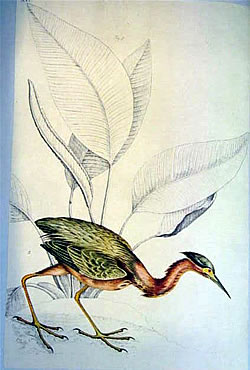 William Bartram (April 20, 1739 - July 22, 1823). Explores southeast from 1773-1777 (http://www.bartramtrail.org/). Publishes his account in 1791 in Travels Through North and South Carolina, Georgia, East and West Florida, the Cherokee Country, etc. Bartram's writing strongly influences romantic poets, and his work is widely read at the time. He helps train others like Meriwether Lewis and Alexander Wilson. Bartram is a collector and artist who sends specimens and drawings to European collectors and scientists. In 1801 he begins keeping bird migration records. In 1802 he meets Alexander Wilson, and gives him a species list of American birds.
William Bartram (April 20, 1739 - July 22, 1823). Explores southeast from 1773-1777 (http://www.bartramtrail.org/). Publishes his account in 1791 in Travels Through North and South Carolina, Georgia, East and West Florida, the Cherokee Country, etc. Bartram's writing strongly influences romantic poets, and his work is widely read at the time. He helps train others like Meriwether Lewis and Alexander Wilson. Bartram is a collector and artist who sends specimens and drawings to European collectors and scientists. In 1801 he begins keeping bird migration records. In 1802 he meets Alexander Wilson, and gives him a species list of American birds.- Bartram was a Philadelphia Quaker, as were many of our early scientists in America. Seems the Quakers believed in education long before it became popular here. Bartram called this bird "Little Green Bittern." The drawing is from the second half of the 18th Century. Bartram influenced and informally taught many of the leading explorers and naturalists of his day including Thomas Nuttall, a great botanist and ornithologist and one of the first scientists to cross North America on foot in the 1830s; Meriwether Lewis (Lewis and Clark Expedition, 1803-5) before he led the expedition west to Oregon; and Alexander Wilson, who became the first artist to try to illustrate all the birds in the U.S. Thomas Say was a young relative of Bartram's and learned much at the Bartrams' extensive gardens. He gave his name to the phoebe genus and discovered many new bird species as naturalist on the Long Expedition to the Rockies, 1819-1820.
- 1803
- Audubon bands an Eastern Phoebe to see if it is the same bird returning to the same nest each spring.
- 1803-5
- Lewis and Clark Expedition from Saint Louis to Astoria at the mouth of the Columbia River, and back. They discover many new species of animals, though much of their information is ignored by science for a century because their complete journals were not published before 1890.
- 1808
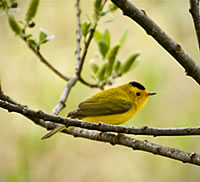 Alexander Wilson (July 6, 1766 – August 23, 1813) was a Scottish-American poet, ornithologist, naturalist and illustrator. Wilson was born in Paisley, Scotland, the son of an illiterate distiller. In 1779 he was apprenticed as a weaver. His main interest at this time was in writing poetry, and his poems commenting on the unfair treatment of the weavers by their employers got him into trouble with the authorities.
Alexander Wilson (July 6, 1766 – August 23, 1813) was a Scottish-American poet, ornithologist, naturalist and illustrator. Wilson was born in Paisley, Scotland, the son of an illiterate distiller. In 1779 he was apprenticed as a weaver. His main interest at this time was in writing poetry, and his poems commenting on the unfair treatment of the weavers by their employers got him into trouble with the authorities.- In 1794 Wilson comes to America and in 1801 he meets William Bartram. In Bartram's library he finds Catesby's earlier works on American natural history. The result is the nine-volume American Ornithology (1808-1814), illustrating 268 species of birds, 26 of which have not previously been described. He died during the writing of the ninth volume, which was completed and published after his death by his friend George Ord. Wilson lies buried next to Ord at Gloria Dei Church cemetery in Philadelphia, Pennsylvania. Wilson gets to draw and describe the birds discovered by Lewis and Clark when they returned in 1805.
- 1820
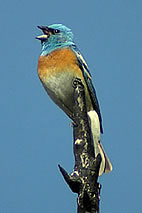 Thomas Say is the naturalist and Titian Peale the artist on the Long Expedition to the Rockies. They discover many new species including Band-tailed Pigeon, Say's Phoebe, Lazuli Bunting and Lark Sparrow.
Thomas Say is the naturalist and Titian Peale the artist on the Long Expedition to the Rockies. They discover many new species including Band-tailed Pigeon, Say's Phoebe, Lazuli Bunting and Lark Sparrow.- 1826
- J.J. Audubon (1785-1851) begins to publish his Birds of America in folio size. He visits Europe, and meets Bewick, Macgillivray, Swainson, et al.
- 1826-7
- British Captain Frederick Beechey, on a Pacific expedition, visits San Francisco and Monterey. His naturalist collects many new species, including Beechey Ground-squirrel, Pygmy Nuthatch, and California Towhee.
- 1827-8
- Dr. Paolo Botta is on a French ship commanded by Captain Duhart-Cilly in San Francisco and along California Coast. He collects the first specimen of Anna's Hummingbird in San Francisco.
- 1832
- Thomas Nuttall (1786-1859) publishes the first handbook for American birds. It is updated and reprinted for sixty years.
- 1834-6
- Nuttall and John Kirk Townsend (1809-1851) on Pacific Coast. Thomas Nuttall quits Harvard post at age 48. Goes to Great Plains, then later to Oregon and California with Townsend and a large fur-trading expedition. Many new species discovered. Many included in Audubon's work. New species included Townsend's namesake warbler, Green-tailed Towhee, Black-footed Albatross, Lark Bunting, Sage Thrasher, Bushtit, Chestnut-backed Chickadee, Black-throated Gray Warbler, Hermit Warbler, Tricolored Blackbird, Mountain Plover, Western Gull, Townsend's Solitaire, Vaux's Swift, Harris's Sparrow, MacGillivray's Warbler and Chestnut-collared Longspur. A number of mammals are named for Townsend, including Townsend's Ground Squirrel (Spermophilus townsendii), Townsend's Chipmunk (Tamias townsendii), Townsend's Pocket Gopher (Thomomys townsendii), Townsend's Mole (Scapanus townsendii), Townsend's Vole (Microtus townsendii), and the Whitetail Jackrabbit (Lepus townsendii). Townsend wrote account of expedition with a list of birds seen, Across the Rockies to the Columbia.
- 1840-44
- Audubon's Birds of America appears in smaller format, popular edition.
- 1843
- Audubon goes on final expedition, up the Missouri River. Recognizes the Western Meadowlark as new species based on its song. Also collects first recognized specimens of Brewer's Blackbird, Bell's Vireo and Sprague's Pipit.
- 1844
- Great Auk goes extinct, last pair shot.
- 1845
- William Gambel returns to Philadelphia with many western bird specimens. He walked to California via Santa Fe, discovers several new bird species including Nuttall's Woodpecker and his namesake quail and Wrentit.
- 1845-47
- Henry David Thoreau (1817-1862) lives at Walden Pond.
- 1846
- Smithsonian founded. New species descriptions still require a dead bird of the species, thus the Ecuadoran San Isidro Owl remains undescribed because it has only been found in small numbers at one location, the San Isidro Lodge on the eastern slope of the Andes.
- 1850
- Fledgling Smithsonian hires Spencer Fullerton Baird.
- 1853
- House Sparrow introduced into North America: Greenwood Cemetery, Brooklyn. thriving on the grain in horse manure, then so plentiful on city and suburban streets and roads.
- 1853-6
- John Cassin begins to publish Illustrations of the Birds of California, Texas, Oregon, British and Russian America. The work is never completed but the first volume includes new species found by Gambel and Heermann: Hutton's Vireo, Heermann's Gull, Rufous-crowned Sparrow and Wrentit.
- 1855
- First known Williamson's Sapsucker collected by the Army's railroad survey near Klamth, Oregon.
- 1860
- Baird, John Cassin and George Lawrence publish their Catalogue of North American Birds.
- Teenager Elliot Coues discovers his first new species—a Baird Sandpiper mixed in with other specimens at the Smithsonian. Thus begins the career of America's top 19th Century ornithologist.
- 1863
- William Burroughs meets Walt Whitman. Burroughs is the most famous nature writer in early 20th Century.
- 1873
- Nuttall Ornithology Club formed in Boston, with Henshaw and Brewster among its members.
- 1874
- Elliott Coues publishes Birds of the Northwest, then a few years later a guide to preserving bird skins with the first American bird checklist. It becomes the basis for all later checklists issued by the AOU.
- 1875
- Last known specimen of Labrador Duck killed.
- 1876
- Boston city forester shoots 89 Northern Shrike to protect the recently established House Sparrow population.
- 1883
- First meeting of the American Ornithological Union in New York City.
- 1886
- AOU publishes first official American bird checklist
- Wilson Ornithological Club founded.
- 1889
- Florence Merriam Bailey publishes Birds Through an Opera-Glass, the first sign that binoculars would replace the shotgun as a way of studying birds in the field.
- 1890
- European Starling introduced into New York by Shakespeare lovers.
- 1894
- Yellowstone National Park closed to all hunting.
- 1895
- Chapman publishes his Handbook Of The Birds Of The Eastern United States.
- 1896
- Harriet Hemenway, a wealthy Boston matron, founds the Massachusetts Audubon Society to fight fashion hunting of birds. One of her club's earliest members is Sarah Orne Jewett, author of a novel about a girl protecting a heron.
- 1900
- First Christmas Bird Count organized by Frank Chapman.
- Lacey Act passed, making it illegal to sell birds in one state that had been shot in another.
- 1902
- Florence Merriam Bailey publishes Handbook of Birds of the Western United States.
- 1904
- Ralph Hoffman publishes his Guide to the Birds of New England.
- 1905
- State Audubon Associations join to form a national organization. Through Audubon, Abbott Thayer pays for the first wardens to protect wild birds in America. Thayer also pays for the expedition to Alaska that discovered the gull named for him.
- 1906
- Chester Reed publishes his Guide to Land Birds and Guide To Water Birds, for the area east of Rockies.
- 1907
- First federal reserve in the west, along the Oregon coast, set up by Theodore Roosevelt at The Arches.
- 1913
- Feather trade effectively killed by federal law. Millinery trade and heron hunting in the 1880s had caused an estimated 200 million birds per year to be killed for their feathers to suit the fashion, mostly used on women's hats.
- First Christmas count over 100 species by William Dawson and bird artist Allen Brooks in San Diego County.
- 1914
- Passenger Pigeon goes extinct.
- 1915
- Cornell Lab of Ornithology founded by Arthur Allen.
- 1918
- Carolina Parakeet goes extinct.
- Migratory Bird Treaty Act passed by U.S.
- 1919
- Cleveland Bent published the first of his bird Live Histories.
- 1922
- Last price list for wild bird egg collecting published in U.S. by the collectors' magazine The Oologist. California Condor egg: $75. Ivory-billed Woodpecker and Passenger Pigeon (already extinct): $100. BH Cowbird 10 cents. Wandering Tattler and Whiskered Auklet were considered so rare as to be priceless. Egg-collecting becomes widely illegal during the Twenties.
- 1929
- Rosalie Edge goes to work changing conservation in America. In 1934 she funds the founding of Hawk Mountain Reserve in Pennsylvania, at a time when raptors were still largely scorned and unprotected.
- First U.S. law creating national wildlife refuges.
- 1932
- Heath Hen goes extinct.
- 1934
- Roger Tory Peterson publishes his first Field Guide.
- 1938
- The last U.S. pictures are taken of Ivory-billed Woodpeckers, and a decade later the last Cuban pictures are taken.
- 1941
- Peterson publishes his Field Guide to Western Birds.
- Cattle Egret self-introduced into the U.S.
- 1958
- Last photo taken of a Bachman's Warbler, now believed extinct.
- 1962
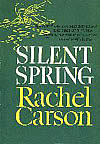 Silent Spring published by Rachel Carson (1907-1964). http://www.rachelcarson.org/ Her "New York Times" obituary is at http://www.rachelcarson.org/RachelCarson.ASPX
Silent Spring published by Rachel Carson (1907-1964). http://www.rachelcarson.org/ Her "New York Times" obituary is at http://www.rachelcarson.org/RachelCarson.ASPX- 1963
- Eskimo Curlew shot in Barbados; none seen since then.
- 1972
- DDT banned in the United States. Peregrine, Osprey and Brown Pelican populations begin to recover.
- 1973
- U.S. Endangered Species Act.
- 1974
- First Marbled Murrelet nests discovered in old-growth forests along coast south of San Francisco.
- 1976
- Harlequin Duck last recorded nesting in Sierra foothills where bird was once regular.
- 1987
- On April 19th the last California Condor in the wild is trapped.
- 1992
- Birds of North America [BNA] publication begins. Now you can subscribe online: http://bna.birds.cornell.edu/bna/
- 1993
- International Migratory Bird Day founded by Cornell and the Smithsonian.
TOWHEE.NET: Harry Fuller, 820 NW 19th Street, McMinnville, OR 97128
website@towhee.net